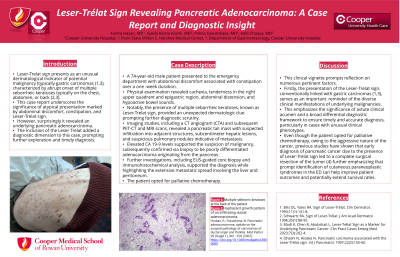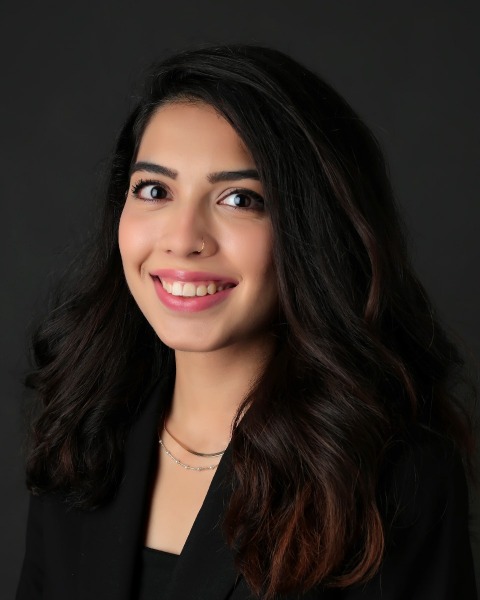Tuesday Poster Session
Category: Biliary/Pancreas
P3548 - Leser-Trélat Sign Revealing Pancreatic Adenocarcinoma: A Case Report and Diagnostic Insight
Tuesday, October 29, 2024
10:30 AM - 4:00 PM ET
Location: Exhibit Hall E

Has Audio

Syeda Kanza Kazmi, MD
Penn State Health Milton S. Hershey Medical Center
Hershey, PA
Presenting Author(s)
Award: Presidential Poster Award
Fariha Hasan, MD1, Syeda Kanza. Kazmi, MD2, Polina Gaisinskaya, MD3, Adib Chaaya, MD3
1Cooper University Hospital, Philadelphia, PA; 2Penn State Health Milton S. Hershey Medical Center, Hershey, PA; 3Cooper Health Gastroenterology, Camden, NJ
Introduction: The Leser-Trélat sign is an unusual dermatological indicator of potential malignancy, typically associated with gastric carcinomas, characterized by the abrupt onset of multiple seborrheic keratoses, typically on the chest, abdomen, or back. This case report highlights the significance of an atypical presentation marked by abdominal discomfort, constipation, and the Leser-Trélat sign, which surprisingly revealed an underlying pancreatic adenocarcinoma. The Leser-Trélat sign added a diagnostic dimension to this case, prompting further exploration.
Case Description/Methods: A 74-year-old male presented with abdominal discomfort and constipation lasting one week. Physical examination revealed cachexia, tenderness in the right upper quadrant and epigastric region, abdominal distension, and hypoactive bowel sounds. The presence of multiple seborrheic keratoses, known as the Leser-Trélat sign, provided an unexpected dermatologic clue, prompting further diagnostic scrutiny. Imaging studies, including a CT angiogram (CTA), PET-CT, and MRI scans, revealed a pancreatic tail mass with suspected infiltration into adjacent structures, subcentimeter hepatic lesions, and suspicious pulmonary nodules indicative of metastasis. Elevated CA 19-9 levels supported the suspicion of malignancy, subsequently confirmed via biopsy to be poorly differentiated adenocarcinoma originating from the pancreas. Further investigations, including EUS-guided core biopsy and immunohistochemical analysis, confirmed the diagnosis while highlighting the extensive metastatic spread involving the liver and peritoneum. The patient opted for palliative chemotherapy.
Discussion: The presentation of the Leser-Trélat sign, conventionally linked with gastric carcinomas, is an important reminder of the diverse clinical manifestations of underlying malignancies. This emphasizes the significance of astute clinical acumen and a broad differential diagnostic framework to ensure timely and accurate diagnosis, particularly in cases with unusual clinical phenotypes. Although our patient was treated with palliative chemotherapy due to metastatic disease, previous studies have shown that early diagnosis of pancreatic cancer due to the presence of the Leser-Trélat sign can lead to complete surgical resection of the tumor. This further emphasizes that prompt identification of cutaneous paraneoplastic syndromes in the emergency department can help improve patient outcomes and potentially extend survival rates.

Disclosures:
Fariha Hasan, MD1, Syeda Kanza. Kazmi, MD2, Polina Gaisinskaya, MD3, Adib Chaaya, MD3. P3548 - Leser-Trélat Sign Revealing Pancreatic Adenocarcinoma: A Case Report and Diagnostic Insight, ACG 2024 Annual Scientific Meeting Abstracts. Philadelphia, PA: American College of Gastroenterology.
Fariha Hasan, MD1, Syeda Kanza. Kazmi, MD2, Polina Gaisinskaya, MD3, Adib Chaaya, MD3
1Cooper University Hospital, Philadelphia, PA; 2Penn State Health Milton S. Hershey Medical Center, Hershey, PA; 3Cooper Health Gastroenterology, Camden, NJ
Introduction: The Leser-Trélat sign is an unusual dermatological indicator of potential malignancy, typically associated with gastric carcinomas, characterized by the abrupt onset of multiple seborrheic keratoses, typically on the chest, abdomen, or back. This case report highlights the significance of an atypical presentation marked by abdominal discomfort, constipation, and the Leser-Trélat sign, which surprisingly revealed an underlying pancreatic adenocarcinoma. The Leser-Trélat sign added a diagnostic dimension to this case, prompting further exploration.
Case Description/Methods: A 74-year-old male presented with abdominal discomfort and constipation lasting one week. Physical examination revealed cachexia, tenderness in the right upper quadrant and epigastric region, abdominal distension, and hypoactive bowel sounds. The presence of multiple seborrheic keratoses, known as the Leser-Trélat sign, provided an unexpected dermatologic clue, prompting further diagnostic scrutiny. Imaging studies, including a CT angiogram (CTA), PET-CT, and MRI scans, revealed a pancreatic tail mass with suspected infiltration into adjacent structures, subcentimeter hepatic lesions, and suspicious pulmonary nodules indicative of metastasis. Elevated CA 19-9 levels supported the suspicion of malignancy, subsequently confirmed via biopsy to be poorly differentiated adenocarcinoma originating from the pancreas. Further investigations, including EUS-guided core biopsy and immunohistochemical analysis, confirmed the diagnosis while highlighting the extensive metastatic spread involving the liver and peritoneum. The patient opted for palliative chemotherapy.
Discussion: The presentation of the Leser-Trélat sign, conventionally linked with gastric carcinomas, is an important reminder of the diverse clinical manifestations of underlying malignancies. This emphasizes the significance of astute clinical acumen and a broad differential diagnostic framework to ensure timely and accurate diagnosis, particularly in cases with unusual clinical phenotypes. Although our patient was treated with palliative chemotherapy due to metastatic disease, previous studies have shown that early diagnosis of pancreatic cancer due to the presence of the Leser-Trélat sign can lead to complete surgical resection of the tumor. This further emphasizes that prompt identification of cutaneous paraneoplastic syndromes in the emergency department can help improve patient outcomes and potentially extend survival rates.

Figure: Leser-Trélat Sign On the Back Revealing Pancreatic Adenocarcinoma
Disclosures:
Fariha Hasan indicated no relevant financial relationships.
Syeda Kazmi indicated no relevant financial relationships.
Polina Gaisinskaya indicated no relevant financial relationships.
Adib Chaaya indicated no relevant financial relationships.
Fariha Hasan, MD1, Syeda Kanza. Kazmi, MD2, Polina Gaisinskaya, MD3, Adib Chaaya, MD3. P3548 - Leser-Trélat Sign Revealing Pancreatic Adenocarcinoma: A Case Report and Diagnostic Insight, ACG 2024 Annual Scientific Meeting Abstracts. Philadelphia, PA: American College of Gastroenterology.

